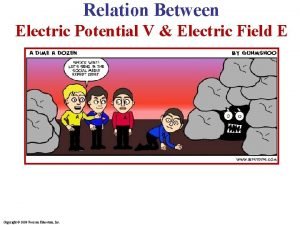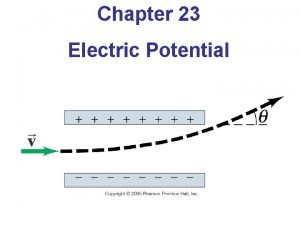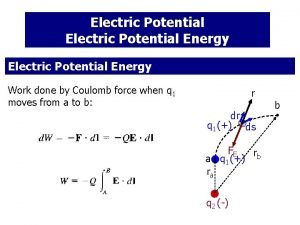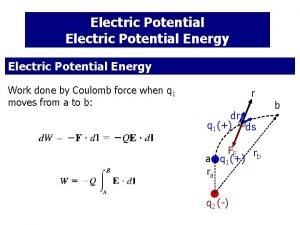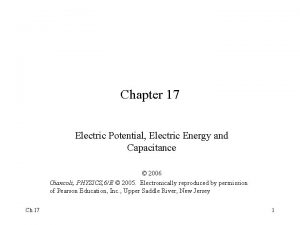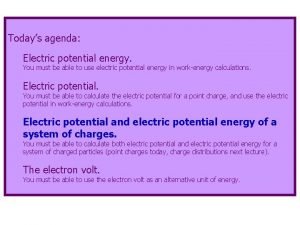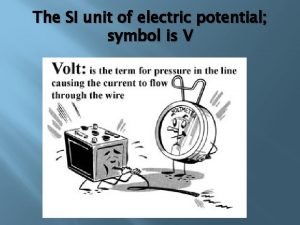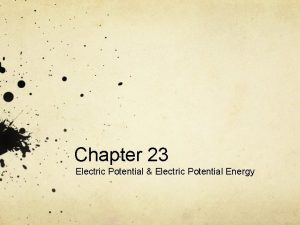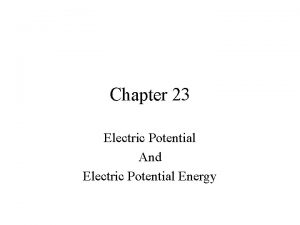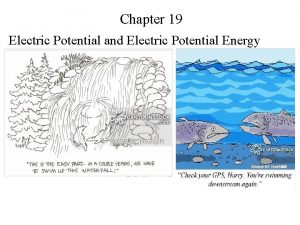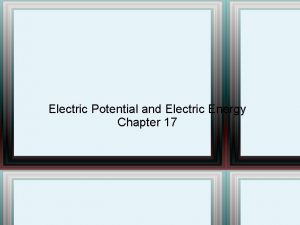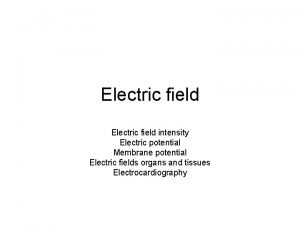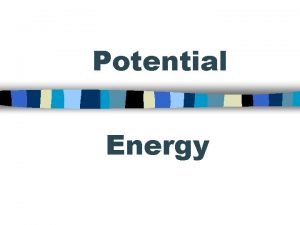Chapter 21 Electric Potential Energy And Electric Potential

















- Slides: 17

Chapter 21 Electric Potential Energy And Electric Potential

Potential Energy § The work done in moving a basketball from position A to position B in the Earth’s gravitational field decreases the gravitational potential energy of this mass (basketball). § Fg = a gm

Electric Potential Energy Similarly… § The work done in moving a positive (test) charge, +qo, from position A to B in this electric field decreases the electric potential energy of this charge. § F = E q o.

§ If we want to move (at constant speed) the test charge qo a distance d, we must exert a force on that charge. § That force is equal (and sometimes opposite) to the electric field force. § FE = E qo § The work done in moving that charge is… § W = F d = E qo d § Work is done by the electrostatic force (similar to work done by the gravitational force on the basketball) to move the test charge qo toward the negative charge. § Charge qo loses potential energy, specifically electrical potential energy as it moves.

§ The work done on the charge is equal to the decrease in electrical potential energy of the charge qo § W = EPEf – EPEi § Just like the change in gravitational potential energy is proportional to the mass ( Peg = mag h), § the electrical potential energy is proportional to the test charge, qo, and this quantity is called the potential difference, V, or § V = VB – VA = EPEB/qo – EPEA/qo = -WAB/qo § V = EPE/qo = -WAB/qo

V = EPE/qo = -WAB/qo Why the negative? ? § V = EPE/qo = -WAB/qo this is negative work because as the charge goes from position A to B, the charge loses electric potential energy, thus the change in electric potential, V, is decreasing. § § § WAB = (+F)·(+d) = PEA – PEB Since PE = PEfinal –PEinitial = PEB – PEA WAB=PEA – PEB= – (PEB – PEA)= – PE Or… EPE = –WAB § V = EPE/qo = -WAB/qo

Potential Energy vs. "Potential" § Voltage is also called "electrical potential. " So. . . is voltage a type of potential energy? Close, but not totally accurate. Confusion between voltage and potential energy is a common mistake. Think of it like this. If you roll a big boulder to the top of a hill, you have stored some potential energy. But after the boulder has rolled back down, THE HILL IS STILL THERE. The hill is like voltage: the height of the hill has "Gravitational Potential. " But the hill is not *made* of Potential Energy, since we need both the hill *and* the boulder before we can create potential energy. The situation with voltage is similar. Before we can store any ELECTRICAL potential energy, we need some charges, but we also need some voltage-field through which to push our charges. The charges are like the boulder, while the voltage is like the hill (volts are like height in feet. Well, sort of. . . ) But we wouldn't say that the Potential Energy is the boulder, or we wouldn't say the hill is the PE. In the same way, we should not say that electric charges are Potential Energy, neither should we say that voltage is Potential Energy. However, there is a close connection between them. Voltage is "electric potential" in approximately the same way that the height of a hill is connected with "gravitational potential. " You can push an electron up a voltage-hill, and if you let it go it will race back down again.

V = Voltage = Electric Potential § The potential difference VB – VA (or V) is the work per unit charge necessary to move a charge at constant speed from point A to point B. § V alone is just the electric potential at that point; just like PEg… it is only the change in PE that is measurable. In other words, you can only compare PE from one point to another. Often we use the earth as PE = 0 to make a reference or starting point.

V = EPE/qo = W/qo § SI units for V: § Joule/Coulomb = Volt § Also: V = W/q = F d/q § Units: Volt = N m/C § 1 V/m = 1 N/C § V/m is a measure of field

§ Electric field lines point in direction of decreasing potential. When a positive test charge, qo, is placed in an electric field, it accelerates in the direction of the field. Its kinetic energy increases and its potential energy decreases. W = PE = KE § For example: If we have a constant electric field of 10 N/C = 10 V/m in the “x” direction, the potential decreases by 10 V for each meter in the “x” direction.

The electron volt (a unit of energy) § Since the joule is a large energy unit, and in dealing with such small energies as that of the electron, atom, etc… § The electron volt (e. V) has been defined as an energy unit (not an SI unit) § 1 e. V = 1. 60 X 10 -19 J = the energy acquired by an electron as a result of moving through a potential difference of 1 volt. § Since the charge of an electron is 1. 60 X 10 -19 C then… § PE = q V=(1. 60 X 10 -19 C) (1. 0 V)=1. 60 X 10 -19 J

Use what you know to solve… § The work done by the electric force as the test charge (qo = +2. 0 X 10 -6 C) moves from A to B is WAB = + 5. 0 X 10 -5 J. § Find the difference, EPE = EPEf – EPEi, in the electrical potential energies of the charge between these points. § Determine the potential difference, V = VB – VA, between these points. § Did you get…? § EPE = EPEf – EPEi = -5. 0 X 10 -5 J § V = VB – VA= EPE/qo = -25 V

A headlight connected to a 12 -V battery § A 12 -V automobile battery with a headlight connected between its terminals… § The positive terminal (pt. A) has a potential that is 12 V higher than the potential at the negative terminal (pt. B). § VB – VA = 12 V § Negative charges are repelled from the negative terminal and travel through the wires and headlight toward the positive terminal. § (Conventional current would say that the positive charges flow from + to –. )

§ As the charge passes through the headlight, all of the charge’s electric potential energy is converted into heat, which causes the filament to glow “white hot” and emit light. § When the charges reach the positive terminal, they no longer have any electric potential energy. § The battery then gives the charges an additional “shot” of electric potential energy by moving the charge to the higher-potential negative terminal, and the cycle is repeated. § In raising the electric potential energy of the charges, the battery does work on the charges, drawing from its reserve of chemical energy to do so.

Determine the number of particles, each carrying a charge of 1. 60 X 10 -19 C that pass between the terminals of a 12 -V car battery when a 60. 0 -Watt headlight burns for one hour. § § § § P = W/t = nrg/t nrg = P·t = (60 J/s)(3600 s) = 216000 J V = EPE /qo qo = EPE/ V = (216000 J) / (12 V) Or…qo= (216000 N·m) / (12 N·m/C) = 18000 C (1 electron/ 1. 60 X 10 -19 C) = 1. 1 X 1023 electrons

A particle with mass of 1. 8 X 10 -5 kg and a positive charge of +3. 0 X 10 -5 C is released from rest at point A and accelerates horizontally until it reaches point B. The only force acting on the particle is an electric force (not shown) and the electric potential at A is 25 -V greater than at B. What is the speed of the particle when it reaches B?

The solution is… § § § § § Total nrg at A = Total nrg at B (Law of conservation of nrg!) KEA + PEg. A + EPEA = KEB + PEg. B + EPEB Since the particle starts from rest, KEA=0 Since the particle “accelerates horizontally, ” there is no change in height, PEg. A & PEg. B = 0 EPEA = KEB + EPEB qo. VA = ½ mv. B 2 + qo. VB qo. VA – qo. VB = ½ mv. B 2 2 qo/m (VA – VB) = v. B 2 v. B= [2(+3. 0 X 10 -5 C)(25 V)/(1. 8 X 10 -5 kg)] § v. B= 9. 1 m/s = velocity at point B
 Electric potential from electric field
Electric potential from electric field Electric potential energy and potential difference
Electric potential energy and potential difference Peelectric
Peelectric Define electric potential and potential difference.
Define electric potential and potential difference. Electric potential and potential difference
Electric potential and potential difference What is electric potential
What is electric potential Work electric potential energy formula
Work electric potential energy formula Electric field and electric potential
Electric field and electric potential Relation between electric field and potential
Relation between electric field and potential Relation between potential energy and electric field
Relation between potential energy and electric field Force is the integral of potential energy
Force is the integral of potential energy Potential energy of an electric field
Potential energy of an electric field Electric potential
Electric potential How to find electric potential energy
How to find electric potential energy Electric potential energy of capacitor
Electric potential energy of capacitor Power formula
Power formula Potential energy of a system of charges
Potential energy of a system of charges Symbol for electric potential energy
Symbol for electric potential energy








